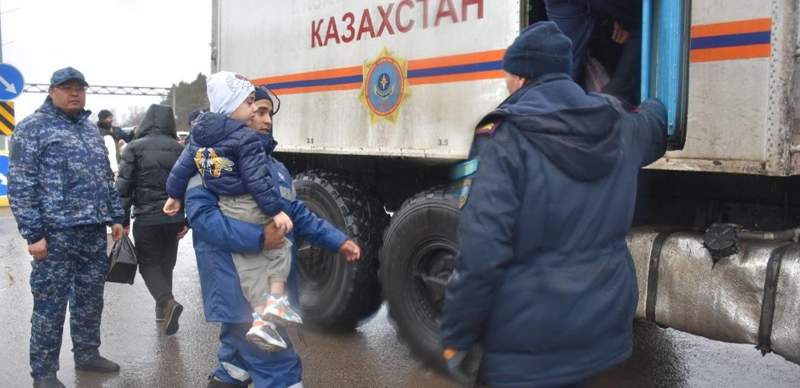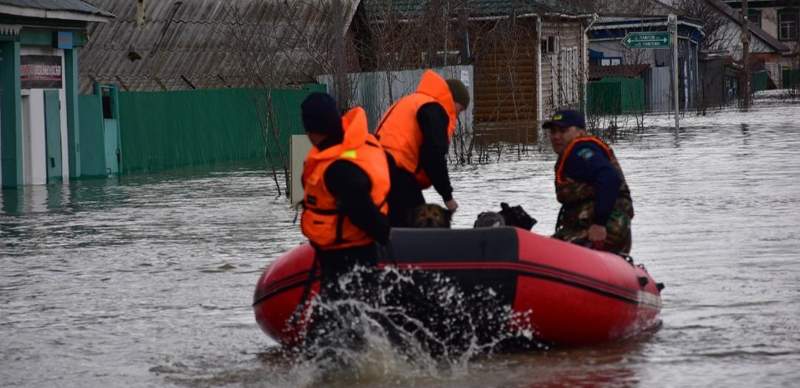Kazakhstan continues to battle floods as water expected to rise

Kazakhstan's Ministry of Emergency Situations continues its surveillance of the country's rivers and reservoirs through aerial surveys and drones as water levels are expected to rise amid the ongoing flood situation, reports Kazinform News Agency correspondent.
Since the onset of the flooding, 113,693 people, including 39,922 children, have been rescued and evacuated with the aid of helicopters and other aircraft. Currently, 7,014 people, 3,144 of whom are children, are housed in temporary accommodation centers. The ministry is also offering psychological support to the victims, including emergency assistance and managing calls to its hotline.
In Kazakhstan, five regions are experiencing severe flooding, affecting 5,708 private residential buildings and 1,609 courtyard areas. To combat the rising waters, emergency teams have pumped out over 9.7 million cubic meters of water and utilized over 2.4 million sandbags and 1.2 million tons of inert materials to reinforce flood defenses.

Dynamics in regions
In the Akmola region, due to heavy snowmelt and rising water levels in the Yessil, Ishim, and Zhabay rivers, 28 private residential homes were flooded. Seventy-four people evacuated beforehand and are staying with relatives.
To protect the populated areas, embankments totaling 38,000 meters in length have been erected and reinforced. More than 2 million cubic meters of water have been pumped out, and over 250,000 bags of inert material have been laid down.

More than 1,200 personnel and 252 pieces of equipment, including 18 watercraft and 65 motor pumps, are involved in ongoing rescue operations.
In the West Kazakhstan region, an intense struggle continues against floods' consequences. One overflow across a local road and 38 cases of roadbed erosion are currently under monitoring.
Nine settlements in the Karatyubinsky and Chingirlau districts remain without transport links, and 1,905 country houses are flooded.
The Zhaiyk (Ural) River continues to rise, with an inflow of 3,000 cubic meters per second. The village areas near the city of Uralsk were flooded due to the flood runoff of the Shagan and Derkul rivers. Rescuers continue laying bags, constructing protective dams and pumping water from flooded areas.

Although dangerous water levels in the region have not yet been reached, evacuation continues in the West Kazakhstan region. As of April 15, 13,259 people, including 5,544 children, have been evacuated, and another 1,821 people are in evacuation centers. Additional forces and resources from seven regions have been mobilized to carry out rescue and other urgent work.
More than 1 million cubic meters of meltwater were pumped out, more than 662,000 bags were laid and 365,000 tons of inert material were used. The rescue operations involved 6,478 people, 1,219 pieces of equipment, 198 water pumping equipment, 156 watercraft and 3 aircraft.
The Department of Emergency Situations of the Aktobe region reports as a result of the erosion of the protective dam due to rising water levels in the Torgai River, the village of Nura was under threat of flooding. Currently, 327 people and 25 pieces of equipment are deployed in the villages of Nura and Mamyr to prevent further penetration of water.
Preventative measures included placing 1,100 sandbags and delivering 390 tons of inert material. A young activist from Aktobe earlier told Kazinform that the situation is stable in the region.
In the North Kazakhstan region, 10,345 people, including 2,328 children, have been evacuated, and 688 are staying in temporary shelters.
In the city of Petropavlovsk and the villages, 2,083 private residential homes and 1,115 courtyard areas remain flooded. Eight road surfaces are under surveillance, and three villages are currently cut off from transportation. Local executive bodies are maintaining communication with the populations of these areas and have established reserves of food and medical supplies.

An operational headquarters operates around the clock.
Volunteer help and humanitarian aid provided
According to the Ministry of Culture and Information, more than 29,000 volunteers are working to address the aftermath of floods. They are organizing humanitarian aid and helping around the clock at aid collection points. As of April 10, 1,713 tons of humanitarian aid had been collected.
Ordinary citizens are coming to these aid collection centers, bringing necessary items.

Over 1,200 members of the National Guard of Kazakhstan are deployed to assist with flood rescue in the country’s west and north.
Medical assistance to those affected by the floods
On April 14, Kazakh Minister of Health Akmaral Alnazarova made a working visit to the West Kazakhstan region. She visited the district hospital in the village of Karatobe and a temporary evacuation point where 77 people are staying, of which 11 with chronic diseases will be sent for treatment to a hospital or sanatorium.
Alnazarova also visited one of the 12 evacuation points in the city of Uralsk, where 13,068 people were temporarily accommodated, including 19 with disabilities and 5,472 children. More than 700 children and 11 pregnant women are under medical supervision.

“Mitigating the consequences of the floods, as well as providing assistance to all those affected, are under the control of the head of state. The government will continue to provide comprehensive support to the victims of this natural disaster. Healthcare facilities will ensure that everyone in need has access to quality medical care and resources. These are common challenges for all of us, which we can overcome by coming together and supporting each other,” Alnazarova stated during a meeting with the public.
During her visit, the minister toured various medical facilities, such as district hospitals and the city cardiology center, where flood-displaced patients were temporarily housed. She also reviewed the operations of laboratories monitoring water and food quality, directing specialists to conduct swift research to ensure drinking water safety amidst the floods.
Experts weigh in
In an interview with Kazinform, analyst Kirill Pavlov shared his forecast for the flood situation in the West Kazakhstan, Atyrau and North Kazakhstan regions. According to him, the peak of floods in Uralsk has already passed, and on April 16, water levels will begin to decline.
Water levels in Atyrau are expected to peak on April 16, followed by a return to April 15 levels on April 17 and a decline on April 18. Increasing floods are predicted for Petropavlovsk: water growth is expected on April 16-18, and the peak will occur on April 19. Water levels will begin to decline only by April 24.
President Kassym-Jomart Tokayev flew into the North Kazakhstan region on April 16 to personally oversee the efforts to address the floods.
